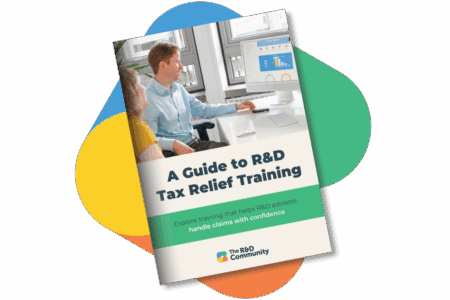Additional Information Form Overview
The form itself has 8 distinct sections covering all aspects of the R&D claim. Here’s a quick overview:
- Company details: Unique Taxpayer Reference (UTR), employer PAYE reference number, VAT registration number, and Standard Industrial Classification (SIC) code.
- Company and Agent Contact details: Information for the senior contact within the company responsible for the claim and any agent involved in preparing it.
- Accounting period: Start and end dates for the period you’re claiming the tax relief, which must match the period shown in your Company Tax Return.
- Relief confirmation: Indicate which relief is being claimed (SME, old RDEC, new RDEC (i.e. the Merged scheme), ERIS or combination) and, if applicable, whether the company is exempt from the PAYE cap.
- Expenditure summary: Breakdown of qualifying expenditure by cost category, with qualifying indirect activities (QIAs) separated out.
- Project details: Number of projects being claimed for in the accounting period and descriptions of the activities undertaken. The number of descriptions required depends on the number of projects.
-
- 1-3 projects: you need to give details for all projects
- 4-10 projects: provide details for at least 50% of qualifying expenditure (minimum 3)
- 11+ projects: provide details for at least 50% of qualifying expenditure (minimum 3, maximum 10)
Project descriptions should cover the following points:
-
- Main field of science or technology: Specify the primary area of science or technology the project addresses.
- Baseline level: Describe the state of scientific or technological knowledge at the start of the project.
- Aims: Outline the advancement(s) in scientific or technological knowledge the company aimed to achieve relative to this baseline.
- Uncertainties: Identify the scientific or technological uncertainties encountered which were not readily available or deducible by a competent professional.
- Solutions: Explain how the project sought to overcome these uncertainties.
-
- Total qualifying expenditure: Amount being claimed for each project.
- Additional details for loss-making R&D-intensive SMEs: Include total relevant expenditure, relevant R&D expenditure, and total relevant expenditure of any connected companies.
The information you submit is critical. HMRC uses the form as its primary screening tool, so even small mistakes can quickly snowball into a longer interaction with the compliance team. Conversely, getting everything spot-on goes a long way to making the rest of the claim’s journey trouble-free.
We’ll go over the most crucial information on how to access the form and avoid these errors, but we also have a course designed to help you really ace it – “Making the Most of HMRC’s Additional Information Forms.” More on that later, or you can go straight to the course overview below:
Learn more about the Additional Information Forms training course
September 2024 changes to the Additional Information Form
In September 2024, HMRC updated the AIF to include new questions pertaining to the new RDEC and ERIS schemes. These changes only affect claims for accounting periods starting on or after 1 April 2024.
Here are the two most important updates:
Claim Details Section
When you reach the claim details, you’ll encounter an information screen outlining the relevant R&D schemes, along with links to HMRC guidance. It’s important to note that a single project may include qualifying expenditure for both ERIS and the Merged scheme. If the claimant company meets the criteria for ERIS, it’s up to you to decide how to split costs between the two schemes.
For companies registered in Northern Ireland, there are additional questions about trade in goods and the ERIS scheme. These questions are designed to ensure that the company doesn’t exceed the ERIS scheme’s net benefit threshold of £250,000 over a three-year period. If the company’s benefits under ERIS exceed this threshold, some expenditure may need to be claimed under the new RDEC scheme, which imposes the overseas expenditure restrictions.
Cost Breakdown: Merged (new RDEC) and ERIS Schemes
The next major change is in the sections that collect cost data for both the Merged and ERIS schemes. While the information requested is mostly the same for both, the key difference is that you must now provide detailed evidence to show that overseas expenditure restrictions have been applied correctly.
You’ll be asked how much of the qualifying expenditure relates to activities conducted overseas, and how much of the EPW and subsequent subcontracted costs are tied to overseas work. If overseas expenditure is included, you’ll need to explain how it qualifies despite the restrictions. Additionally, for contracted-out activities, you’ll be required to provide details of the top ten contractors incurring qualifying costs—listing each company’s name, whether it’s registered in the UK or overseas, and, if available, its company number.
Preparing this level of detail will take some planning, as it requires a thorough understanding of project activities and a more granular breakdown of EPW and contractor costs.
These changes have added another layer of complexity to the AIF. But when you get your head round them and update your processes, you’ll stand a much better chance of avoiding a compliance check.
Additional Information Form templates and guidance
The AIF is the main thing HMRC will look at when reviewing your client’s claim and deciding whether to open an enquiry.
That means it’s essential that you understand exactly how to use the form to best present your client’s claim. That’s exactly the idea behind our “Making the Most of HMRC’s Additional Information Forms” course.
This course is your template to completing the Additional Information Form with the right information in the right format.
Once you’ve taken it, you’ll have an effective process for preparing the information you need to include, and you’ll know exactly how to present a strong case to HMRC to support your clients’ claims.
It includes detailed guidance on how to structure your project descriptions, and everything else you’ll need to include in your submission.
Learn more about the Additional Information Forms training course
Feedback from previous customers
93% of previous customers rated this course as Useful or Very Useful.
“Great run through of the AIF, especially useful to me is the splitting out of RDEC parts of a claim.” – Daniel Chatterton, Zyla Accountants
“Given me some good ideas on structuring the report for the claim.” – Scott Coggill, Simply R&D
“This course is crucial if you want to fully understand the complexities of this process in a clear and concise way.” – Rosie Guard, Minerva Innovation Group
“It is useful if you are looking to see each aspect of the AIF broken down systematically.” – Callum McCusker, Streets Accountants
“I would say this course is one of the best in covering the broader aspects of R&D, and aspects could be used to train new staff in less technical roles or even be client-facing, for those who want to learn more/want to upskill clients.” – Mitchell Poyzer, Acute Business Advisory
Explore the AIF training course
Preparing to submit Additional Information Forms for an R&D claim
The chances are that most of you will already have submitted an Additional Information Form. But if you’re just setting up your own R&D service, or you’ve always passed claims over to the client’s accountant to submit, then you may need to know how to get everything ready.
Set up an Agent Services Account
To fill in an Additional Information Form for your client, you need an Agent Services Account with HMRC. This is the online portal which was set up to support Making Tax Digital. HMRC are now using it to support other services too – like the Additional Information Form.
If you’re an accountant, you may already have Online Agent Authorisation for your clients. This allows you to submit Corporation Tax returns to HMRC through Gov.uk or through commercial accounting software. This is entirely separate from the Agent Services Account.
- If you want to submit the CT600 and the AIF, you’ll need both the Online Agent Authorisation and the Agent Services Account.
- If you only want to submit the Additional Information Form, because you’re an R&D consultant, you’ll only need the Agent Services Account.
Not sure which kind of account you need? HMRC lists out the tools available under the two types of account. As of the publication of this article, the R&D tax relief Additional Information Form has not yet been added to the list under the Agent Services Account.
You can visit this page to set up an Agent Services Account.
If you’re already registered as an agent of any kind with HMRC, you can go ahead and create an account. If this will be your first agent account, you will need to register by post before you do anything else.
It’s also worth noting that, in a pinch, your client can submit the Additional Information Form through their own account. You should never ask them for their log in details. Instead, you should give them all the details to input into the form. We don’t recommend taking this approach as standard practice, as clients often have a lower level of understanding and it’s easy for errors to creep in. However, this approach may be useful if you have a tight deadline and are unable to submit the form yourself before the claim window expires.
Sort out your AML registration
You need to include details of your Anti-Money Laundering registration when applying for your Agent Services Account. In HMRC’s eyes, anyone who prepares and submits R&D claims is giving tax advice. This means it’s essential that you’re registered and performing the right AML checks.
If you’re an accountant, or a member of one of the PCRT bodies, you’ll be on top of this already. If you’re not, you can register directly with HMRC.
Read our AML overview to find out what’s required of advisors and how to get registered.
Take some training on best practices for the Additional Information Form
If you haven’t already, check out our dedicated course on Making the Most of HMRC’s Additional Information Form.
There’s no better way to ensure you’re well equipped and prepared to make a high-quality submission on behalf of your R&D clients.
Learn more about the Additional Information Forms training course
Make sure your client has signed off
Before you submit the form on your client’s behalf, we recommend that you show them the completed copy that you’ve saved from the system. This lets your client review it and give their final approval. It’s always important to make sure the client has full visibility of the claim at every stage of the process. Unless they’re fully involved in the claim, their risk of receiving a penalty after an enquiry could significantly increase.
In Summary
Completing the Additional Information Form is now a core part of any R&D tax relief claim, so being well prepared will maximise your clients’ chances of success.
All of the systems, processes and knowledge required to make the most of this opportunity to present a strong case for your client’s claim to HMRC have become essential tools for the job.





